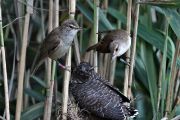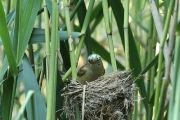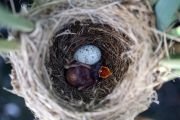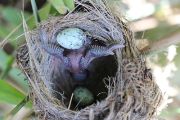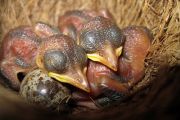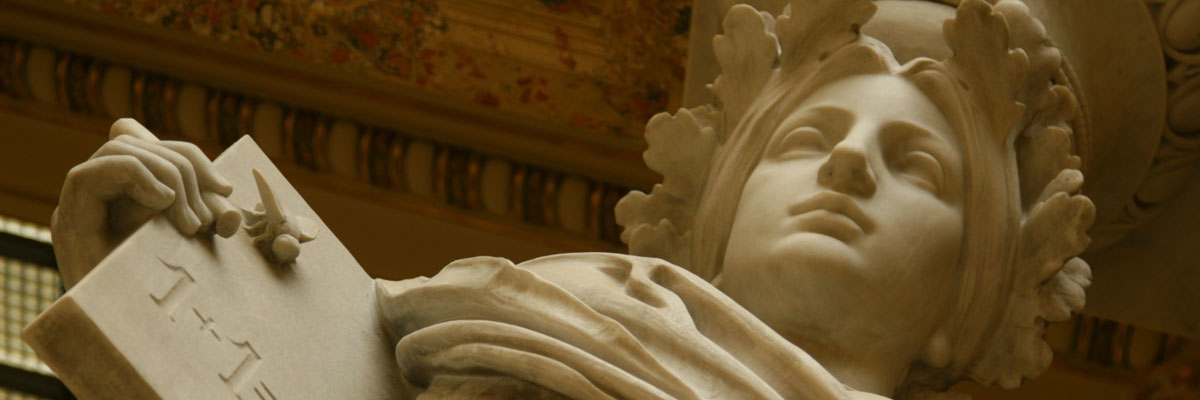
Cuckoos remember nests that have already been parasitized
24. 01. 2023
Don't put all your eggs in one basket - this old saying is also followed by cuckoos. This was discovered by a team of scientists from the Institute of Vertebrate Biology of the CAS, the Faculty of Science of the University of South Bohemia, and the University of Essex. The results of more than 15 years of research showed that when multiple cuckoo eggs were found in a great reed warbler nest, they always came from different females.
Cuckoos are brood parasites, which means they lay their own eggs in the nests of other bird species. In the Czech Republic, most commonly in great reed warblers´ nests. Almost every third parasitized nest happens to have multiple cuckoo eggs.
However, it has not yet been clear whether the eggs come from the same female cuckoo. "In our study, we have focused on uncovering the factors that underlie this phenomenon. We have also confirmed the identity of the cuckoo eggs in the host nest using genetic analyses carried out by colleagues from the Faculty of Science of the University of South Bohemia," explains Marcel Honza from the Institute of Vertebrate Biology of the CAS, lead author of the paper.
"The data showed that even in cases where up to five cuckoo eggs were found in the nest of the great reed warbler, they always came from different females."
Cuckoos must time their laying correctly and remember the host nests
"Parasitizing an already parasitized nest is a mistake from the perspective of the individual. Indeed, the egg laid second and next in order is likely to hatch later. And the cuckoo that hatches first removes all the contents of the nest soon after hatching, i.e., with the eggs of the host and the eggs or chicks of other female cuckoos," explains Marcel Honza. "The fact that a particular female does not make a mistake in the sense of re-parasitizing the nest is another interesting adaptation of cuckoos to this unusual way of reproduction."
The study, whose uniqueness lies in the sheer length of the research, spanning more than 15 years, contributes to the understanding of host-parasite relationships and is another pebble in the complex mosaic of this system. "Such a long-term and systematic research is unique in the current conditions of funding rather short-term projects," points out Petr Procházka, co-author of the study from the Institute of Vertebrate Biology of the CAS, who has been involved in data collection since the very beginning of the long-term research.
"Over 15 years, we have collected data from about 1,500 great reed warblers´ nests. Thanks to the long time series of data, we found that multiple nest parasitism occurs mainly during periods when nests suitable for parasitism are scarce. This is because cuckoos must time their parasitism correctly and lay their eggs at a time when the female hosts are laying eggs themselves."
"Only after all the eggs have been laid, which means usually five eggs in case of great reed warblers, do the female great reed warblers start to warm up the eggs and a cuckoo egg laid on time has a good chance of hatching first," explains Petr Procházka.
"Our previous results suggest that egg-laying error, i.e., bad timing, occurs in about 5% of cases. These are, for example, situations where a female cuckoo has laid her eggs in an abandoned nest or in a nest with already incubated eggs or chicks," adds Michal Šulc from the Institute of Vertebrate Biology of the CAS, who participated in the data collection and analyses.
"In the context of multiple parasitism, it will be interesting to look at, for example, the cognitive abilities of female cuckoos. Specifically, which stimuli they use to locate host nests in space and time," concludes Marcel Honza.
The results of the study were published in the Behavioral Ecology and Sociology journal.
Read also
- High-energy cosmic rays dominated by heavy METALS
- Genome Tool Developed at CAS Featured in PLoS Genetics
- Why do brain cancer cells steal mitochondria?
- Secrets of the Nano- World: a new comic book about nanotechnology
- Teen duo from Slovakia and Czechia named Global Winner for clean water solution
- Professor Pavel Hozák Receives the Paul Nakane Prize
- Neutrino is lighter than previously thought
- The Earth Prize 2025 goes to Czechia and Slovakia for pioneering water purifier
- Scientists discover compound that “should not exist”
- Horizontal mitochondrial transfer is a key process in tumor biology
The Czech Academy of Sciences (the CAS)
The mission of the CAS
The primary mission of the CAS is to conduct research in a broad spectrum of natural, technical and social sciences as well as humanities. This research aims to advance progress of scientific knowledge at the international level, considering, however, the specific needs of the Czech society and the national culture.
President of the CAS
Prof. Eva Zažímalová has started her second term of office in May 2021. She is a respected scientist, and a Professor of Plant Anatomy and Physiology.
She is also a part of GCSA of the EU.
